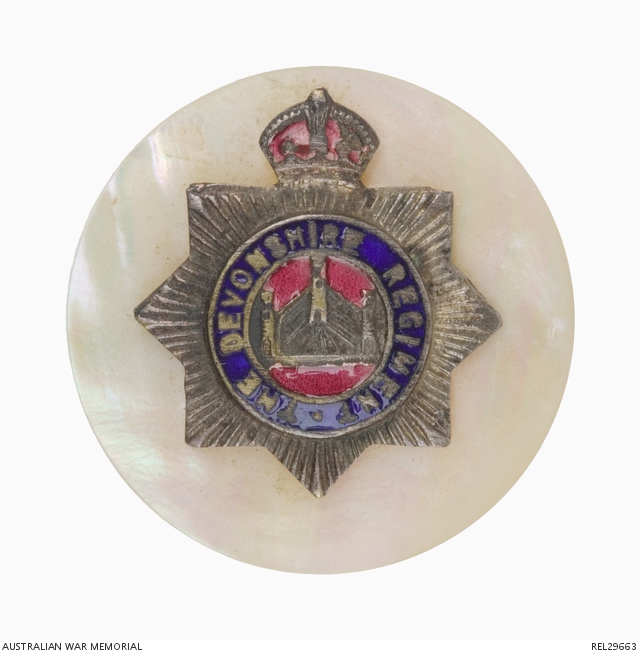Mother of pearl sweetheart jewellery and souvenirs
During the First and Second World Wars, Australians sent home jewellery, boxes, bibles and prayer books made from or decorated with mother of pearl (nacre) made in the Middle East, England, the South West Pacific, Australia and elsewhere. Unfortunately the history of the manufacture and sale of many of these items is not recorded. The information below is based on newspaper accounts and advertisements, personal accounts, and visual inspection of the Memorial’s and other collections.
Powder compact with carved mother of pearl decoration on the lid made in Palestine in 1941
Enamelled mother of pearl brooches: First and Second World War
Mother of pearl brooches with detailed enamelled metal military badges or hand-engraved silver badges attached to the front were popular as military sweetheart brooches during the First World War.
These brooches, made in Birmingham or other parts of England, were available in a vast array of unit badge designs. While they were primarily made for British units, examples of unit badges of the Commonwealth nations were also produced and vary in quality. Some consist solely of a mother of pearl disc with an enamelled unit badge in miniature. Some have a metal frame and backing. Some better quality examples have silver frames and/or sliver backing plates. The latter may also have silver hallmarks that indicate when, where, and by whom the brooches were made.
Most date to the First World War, although some designs were produced during the Second World War. If a unit served in both wars, it can be hard to determine the time period of the brooch.
Palestine souvenirs: First and Second World War
The greatest variety of military-themed mother of pearl souvenirs were made in Bethlehem, Palestine, where a well-established industry had been introduced hundreds of years earlier by Franciscan friars. Rosary beads, face powder compacts, brooches and necklaces, decorated bibles and inlaid olive wood boxes were among the items made or decorated with mother of pearl. Souvenirs marked as originating from Jerusalem or other Middle Eastern towns often had mother of pearl carved in Bethlehem for those tourist markets.
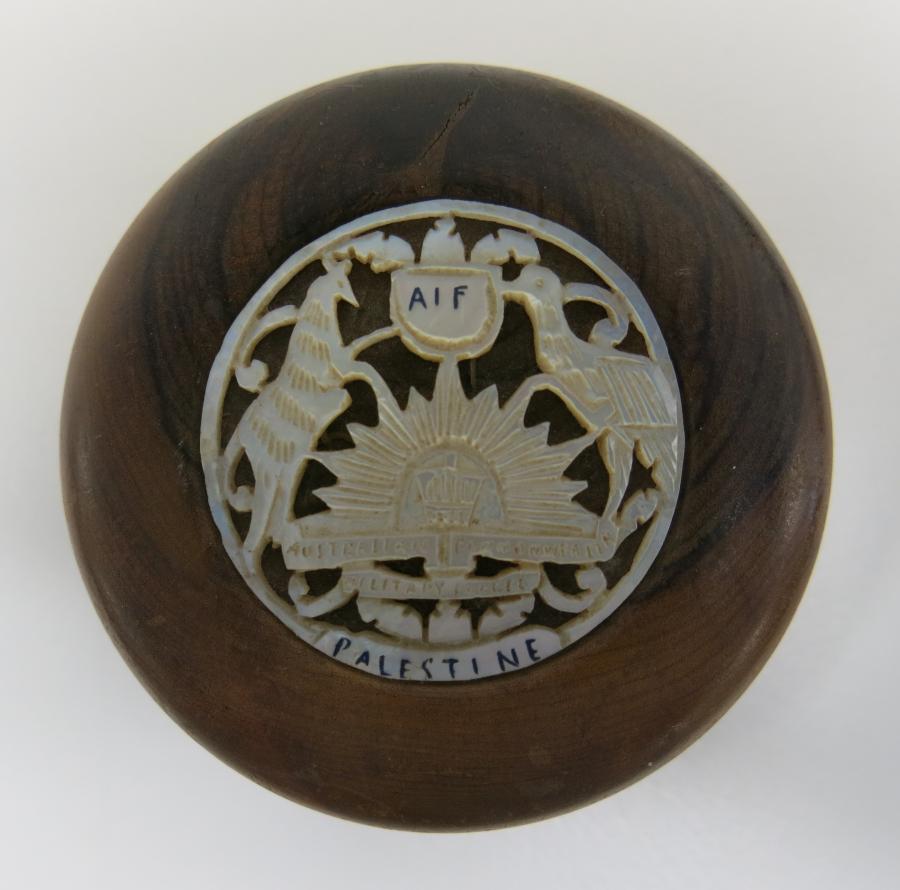
Decorated lid from a Second World War olive wood box
Some items have “Palestine”, “Jerusalem” or “Bethlehem” engraved on them, or contain mother of pearl inlaid in olive wood, indicating their origin. For items without such markings, those made in Palestine can often be identified by the presence of intricate carving, highly-detailed voided scrollwork or filigree designs, carved text highlighted in blue paint, or birds painted with red, black or blue eyes.
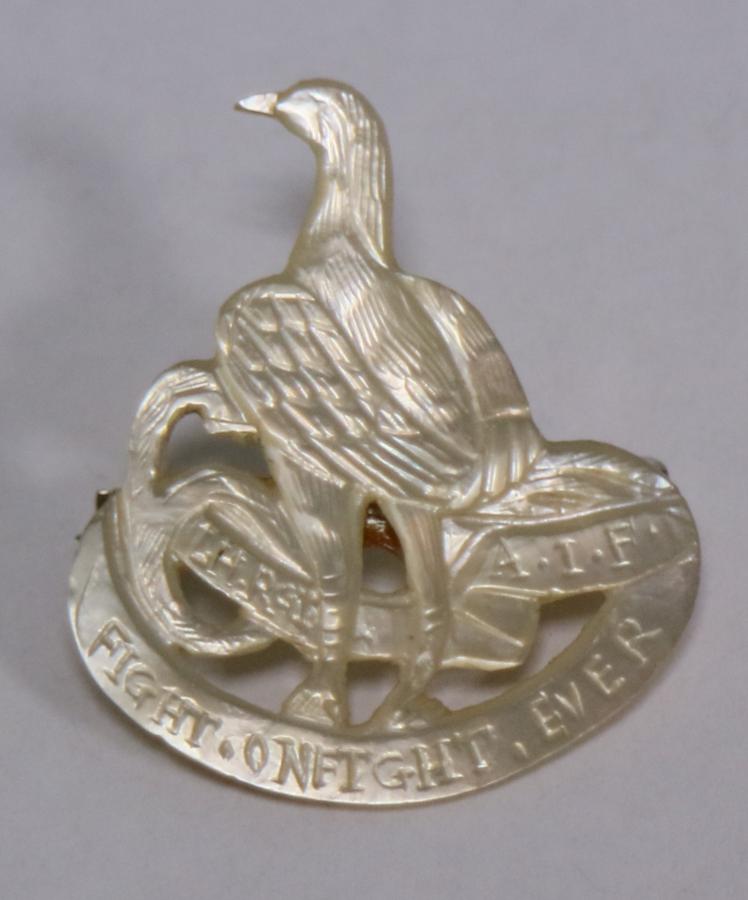
First World War carved brooch of the unofficial unit badge for the 6th Light Horse Regiment, AIF
Before the First World War, souvenirs for tourists to the Holy Land included religious imagery such as crosses and crucifixes, the Star of Bethlehem (a five-pointed star), the Star of David (six-pointed star) and doves. Rosary beads were made from offcuts. After Bethlehem was captured by British and Commonwealth forces in late 1917 a new market developed targeting allied soldiers. Unit badges rendered in carved mother of pearl were popular as sweetheart brooches. The Rising Sun badge was the core component to most Australian-themed brooches.
In the interwar years some brooches were made for British units serving in the British Mandate of Palestine. A large variety of unit badge brooches were made during the Second World War, many of which replicate designs used during the First World War. Because of this, it can be hard to tell if a brooch was produced during the First World War or Second World War.
Dating brooches is easier in the case of units created after the First World War, or those that did not exist by the time of the Second Word War. Comparing the movements of units during both wars can also help in determining the age of mother of pearl souvenirs. The fact that the AIF used the same badge in both world wars, however, means that it can be almost impossible to determine the date of some brooches.
The original source for the mother of pearl used in Palestine was the Red Sea, but by the Second World War it was also being imported from a number of countries, including Australia.
South West Pacific and Australia: Second World War
During the Second World War, some mother of pearl souvenirs were made by servicemen for their families and friends; some were commercially made by locals in Australia (including the Torres Strait), Papua New Guinea, and other islands in the South West Pacific; and some were made as part of a soldier souvenir “cottage industry” known as the “foreigner trade”. If the history of the item has been lost it can be hard to identify where and by whom an item has been manufactured.
Handmade mother of pearl V for victory brooch with cast silver Spitfire, made in Australia or the South West Pacific Area. Based on the quality it was possibly made as part of the foreigner trade.
Mother of pearl and wire sweetheart brooches were popular during the Second World War, and were available for sale at jewellers, department and gift stores in Australia. A version of these souvenirs existed before the war, made from hearts and leaves carved from mother of pearl, with a name or “Mother” shaped from gilded or silver wire, and sometimes with a small pendant containing the Lord’s Prayer dangling from the mother of pearl.
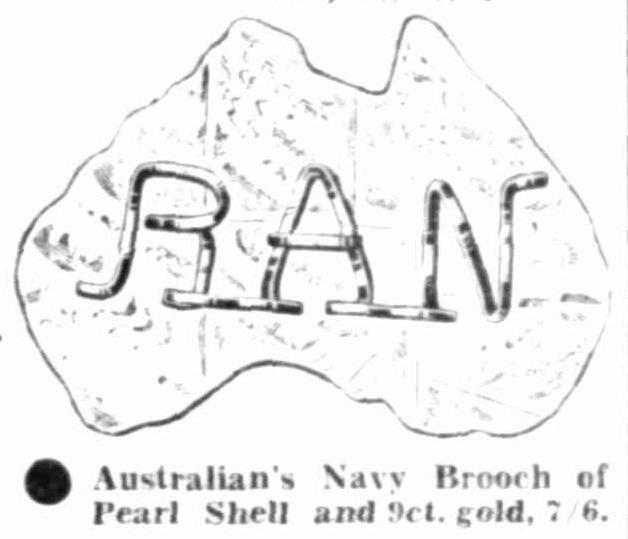
Caris Bros of Western Australia advertisement for the “RAN” brooch sold in Australia from c 1940-1942 (source: The West Australian, Perth 2 April 41 via Trove https://trove.nla.gov.au/newspaper/
Hearts and leaves brooches continued to be made during the early stages of the war. From 1940, navy, army, air force and patriotic brooches in the shape of mainland Australia were also available. Advertising for these brooches does not occur after 1942, likely as a response to the ban on the manufacture of jewellery as unnecessary luxury items. This ban was not lifted until September 1945, which would indicate that military-themed mother of pearl and wire brooches date from 1940 to 1942.
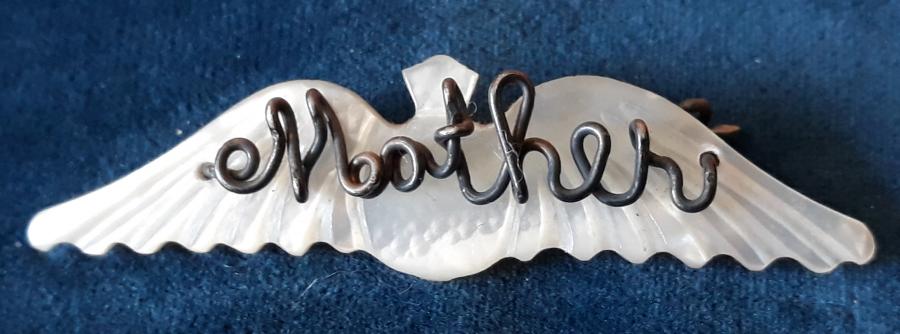
“Mother” RAAF brooch sold in Australia from c 1940 – 1942 (source: private collection)
Military-themed brooches were not made after the war, but non-military mother of pearl brooches, including map of Australia patriotic brooches, were made from 1946, with some designs available until at least 1950.
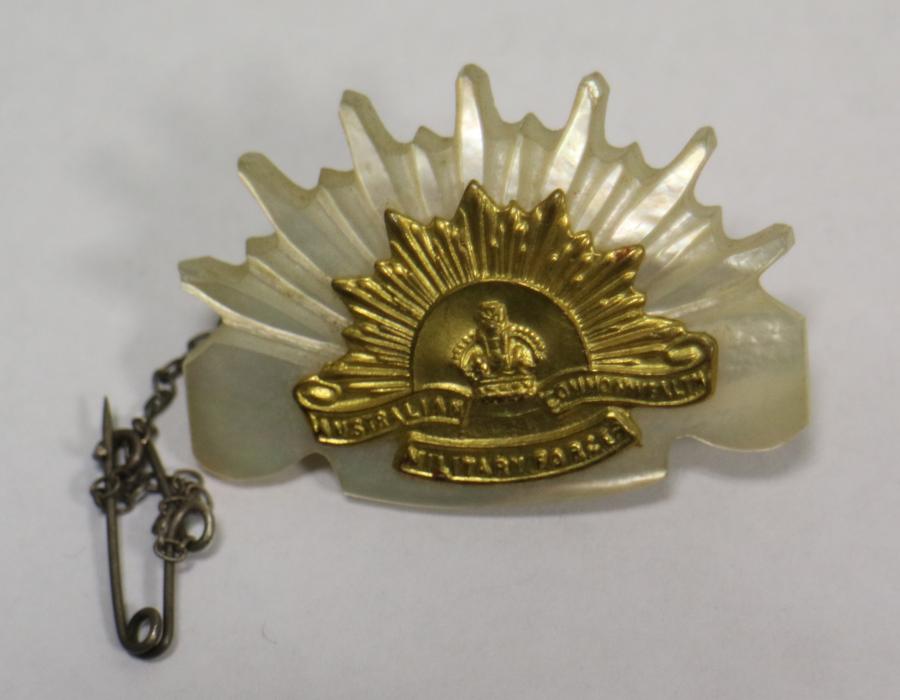
Mother of pearl sweetheart brooch with gilded miniature Rising Sun badge.
Other brooches believed to have been available in Australia early in the Second World War also have carved mother of pearl bases but are overlayed with a small gilded metal version of the Rising Sun badge, or a small enamelled version of the Rising Sun badge or a RAAF badge. It is possible naval examples were also available but none have been sighted by staff.
As with the wire brooches, these come in a variety of shapes, including the Rising Sun badge, map of mainland Australia, boomerangs and even military novelty designs, such as tanks.
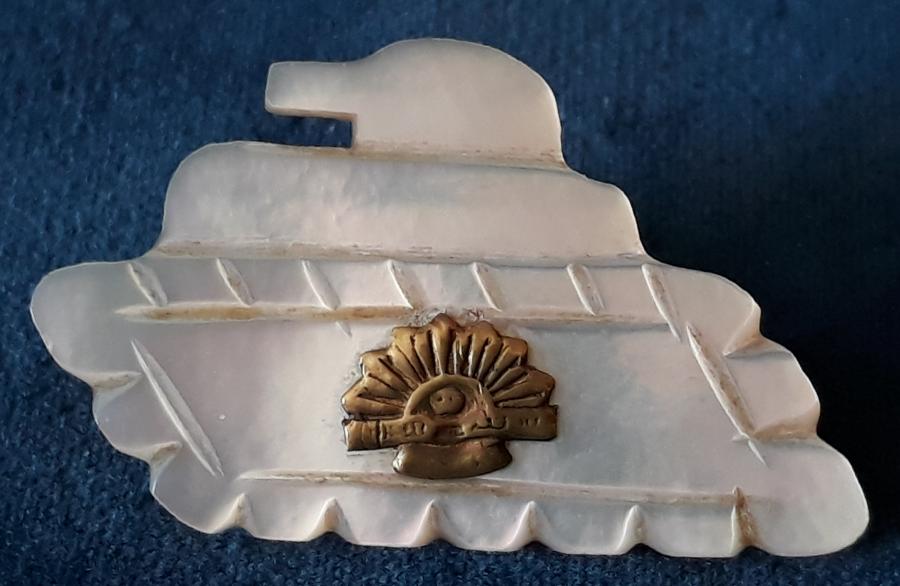
Mother of pearl tank brooch with gilded miniature Rising Sun badge
Identity discs: Second World War
One of the rarer and more unusual mother of pearl souvenirs are replica identity discs that date to the Second World War. Few examples exist and their place of manufacture is unknown, although it may have been the Northern Territory, where the owners of two of the sets are known to have served and where mother of pearl product manufacture took place. However, they may have been made somewhere in the South West Pacific.
Improvised mother of pearl identity discs that resemble those issued by the AIF made for Major General John Murray in Palestine or Australia.
Novel, Australiana mother of pearl identity discs owned by Private Harold Montgomery in the Second World War.
Sources:
AWM Collection and donor files
Inspection of the AWM collection
Inspection of a private collection
Mother of Pearl souvenirs online (images available via Pinterest https://www.pinterest.com.au/dirt73/mother-of-pearl-sweetheart-brooches-etc/)
Newspaper advertisements from 1938–1950 via Trove - https://trove.nla.gov.au/newspaper/
“Mother-O’-Pearl: How to make an Attractive Brooch”, Arthur John Keeling, Western Mail (Perth), 15 March 1945 (via Trove)
“Mother-of-Pearl Workers”, The Albury Banner and Wodonga Express, 29 June 1906
“Bethlehem’s Industry”, The Scone Advocate, 18 October 1912
“A trip to Bethlehem: Life in Syria” [from soldier’s letters], Murrumburrah Signal and County of Harden Advocate, 25 September 1941
“A visit to the stable and manger where Christ once lay in a stable at Bethlehem: Private Hugh Siney’s fine letter”, Northern Argus (Clare SA) 21 March 1941
“In Jerusalem: Visit to Bethlehem” [letter from Lance Corporal R G Penny], Cairns Post, 30 April 1941
“The Recent Development of Crafts and Industries in Palestine” by W.A. Stewart published in Africa: Journal of the International African Institute, Vol. 14 No. 5 (Jan 1944)

